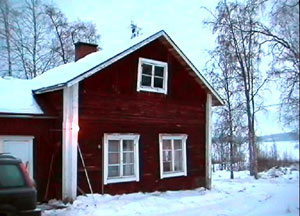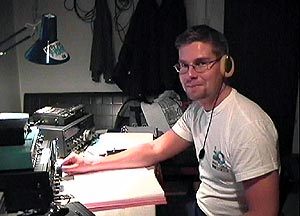|
LEM158 DXpedition
Report
December 1-8, 2001
by Mika Mäkeläinen
We spent the
week around Finland's Independence day (December
6th) in Lemmenjoki, celebrating our independence
of Finnish radio stations. Once again the polar
night proved to be the perfect timing, giving us
an almost continuous flow of distant radio stations
on the mediumwave band. Our best catches this year
were from China, but we also enjoyed a pretty stable
reception of signals from the East Coast of North
America.
 |
| Home sweet home - for one
week |
Jim's
Honda was jampacked with radio equipment and handed
over to the State Railways for overnight transportation
from Helsinki to Kolari on Friday, November 30th.
After one beer, we were ready for bed, but especially
Mika, being
so anxious to get to play with the receivers, spent
a rather restless night on the train.
We arrived at around 9.30 a.m.,
but it was still dark. An hour's drive from Kolari,
the Levi mountain resort was the last outpost before
wilderness, and that's where we stocked groceries
and had the last decent meal - yes, reindeer pizza
for Mika - for a week.
Antennae intact
We saw hardly anyone on
the road from Levi to Lemmenjoki.
Driving in pleasant wintry weather, and without
hitting the ubiquituous reindeer herds, we arrived
in Lemmenjoki well before 3 p.m. local time (1300
UTC) on Saturday December 1st, and had the antennae
sorted out and most of our gear in place before
1400 UTC.
It had already been 11
days before the departure of the previous DXpeditionists,
so finding nearly all permanent antennae functioning
well was a positive sign. Our DXpedition was the
6th of this season, and the 158th of all DXpeditions
to this location, thus the abbreviation LEM158.
Our antennae and equipment
differed only slightly from last year.
The first 24 hours
When we switched our receivers
on, not a single Transatlantic station was audible,
but there were pretty strong signals from China.
Good enough. It was already pitch-dark, and very
soon the few Asian AM stations disappeared as Europeans
invaded the band at intervals of 9 kHz, but we were
too excited to try to get any sleep.
 |
| What's so funny? |
Normally evening activity would
concentrate on scanning for random outbreaks of
Asians or the more predictable local breaks of Spanish
stations, but as there were hardly any local inserts
on Saturday, we caught nothing. Around midnight
shortwave stations from Brazil came in exceptionally
well, and we identified stations like Rádio
Congonhas (4775 kHz) and Rádio Cultura de
Campos (4955 kHz). Practically nothing on AM, so
it was a quiet night thereafter.
Sunday
morning (after 0530 UTC) brought the first coveted
sounds from North America; mostly from the East
Coast. No sensational catches this morning, but
it was a good feeling.
In the afternoon we kept an extremely
close watch at Asian stations, and were happy to
hear the first stations rise above the noise at
1100 UTC. One of the most welcome catches was DXJR,
a new Philippino station on 1575 kHz, occasionally
beating even the superpower Thai station, then signing
off early. Additionally, pretty rare Chinese local
and regional stations were observed on frequencies
such as 1584 and 1431 kHz.
China jubilee
LEM158 became our best ever
DXpedition in terms of logging new Chinese AM stations.
Chinese language was heard virtually every afternoon
around 1200-1300 UTC on many frequencies, but Friday
December 7th was a field day beyond our wildest expectations.
Chinese stations ruled the band from their appearance
at 1020 UTC all the way until around 1600 UTC.
 |
| Loads of Chinese on the dial,
can't complain! |
We were especially intrigued
by the many local dialects heard aside from standard
Chinese and Cantonese. Station identifications heard
in these strange minority languages (on frequencies
such as 1584, 1512 and 1368 kHz) are giving us a
hard time, so if you know any sinologists, help
on resolving some mystery announcements would be
most welcome.
Some of the most fascinating
catches identified so far include Haixia zhi Sheng
on 666 kHz and Nei Monggol PBS on 1152 kHz. After
a semi-local Latvian station had recently vacated
the frequency of 1350 kHz, we had a constant watch
on this frequency, and were pretty successful in
emptying it of Chinese and some other Asian stations
as well.
Otherwise Asian signals
were relatively weak and few. The conditions didn't
favor Japan, the Koreas, the Philippines - and not
even Thailand, India or Iran, as often associated
with below-average conditions. Despite keeping an
eye on the X-band, we didn't hear any AM stations
from the general direction of Australia, and not
even the usual indicator RRI Jakarta on 999 kHz
showed up.
Stuck on the East
Coast
After Sino DX, it became
our second major effort to find new stations from
the East Coast of the U.S. and Canada. Conditions
toward North America repeated the same pattern almost
every day, with East Coast stations best audible
at daybreak around 0700-0900 UTC, and disappering
soon thereafter. A few dominant stations from the
Great Lakes region were audible already at nighttime
on most nights, but nothing of interest to us.
Geographically, for the
first few days, stations were heard almost exclusively
East of the Appalachians and from around Lake Erie
and Lake Ontario. This narrow scope was very welcome,
as it kept many Midwest dominants comfortably at
bay. The East Coast came best on Monday, December
3rd, when we were able to identify a number of stations
previously unheard by us, such as 790 CFAN, 830
WCRN, 900 CKDH, 1160 WMVI, 1230 WMOU, 1570 WBUG,
1580 WEAM and 1600 WKWF.
Later during the week also
Midwest stations became audible, and on Thursday,
December 6th, we had our first afternoon opening
from the West Coast. KVRI Blaine WA (1600 kHz),
with a rare format of chanting and Indian movie
melodies, was logged for the first time in Finland.
This station is likely to become one of the dominant
stations on the frequency.
The X-band was under special
scrutiny, but all stations identified had been heard
in Finland already before.
Tame Latin performance
There was no abundance
of South nor Central American stations. Nighttime
reception was much below average, and a couple of
Brazilians on shortwave was just about all worth
mentioning.
In the morning hours a
few Cubans were identified among East Coast stations,
but aside from that, Jim's catch of WRSJ Bayamon
PR (1560 kHz) and Mika's catch of Radio Tricolor,
Guayaquil (1250 kHz), both on Friday, December 7th,
were among the few highlights.
Midwinter in Finland is
unique, because it offers the once-in-a-year chance
to hear Latin American stations on shortwave as
they begin their broadcast day. Taking advantage
of this, we managed to pick up Radio Imperio, Chiclayo
(4389 kHz), Radio Buenas Nuevas, San Sebastián
(4799.8 kHz) and Radio Casino, Limón (5953.9
kHz).
Eurosclerosis
The closest European equivalents
to graveyard channels are the frequencies of 1602,
1584 and 1485 kHz. Unfortunately, as usually is
the case in Lapland, 1602 kHz was completely destroyed
by Radio Egerszeg's poor modulation and 1584 kHz
was dominated by Iran, so no new catches this time.
Mika scored the remaining
local Belgian stations, but otherwise we didn't
get much anything from Europe. It was disappointing
that GTRK Mordoviya, Saransk, had moved from 1062
kHz to 1080 kHz, destroying a channel which used
to be very good for Asian DXing.
We kept a close watch on
Spanish local breaks, but as usually, reception
conditions favored the northwestern corner of the
country, meaning a meager haul of new stations.
Stable conditions
Solar activity was very stable
the entire week, so it didn't come as a surprise
that African AM stations didn't show up. Solar flux
started at 226, hit a high of 245 on Monday, December
3rd and returned back to 226 by the end of the week.
A-index varied in the range of 3-10, solar activity
was low to moderate and the geomagnetic field was
quiet to unsettled every day. Beautiful northern
lights (aurora borealis) were visible on one evening.
 |
| No sleep for some time? |
Weatherwise it was a pretty
normal week in Lemmenjoki. Temperatures varied from
-2 to -20 degrees Celsius, so wandering in the forest
checking the antennae wasn't an overly arduous undertaking.
Happy but tired - after
an average dose of five hours of sleep per night
- we packed our gear after midday local time on
Saturday, December 8th. Our successors, Per-Ole
Stenman and Mikael Dalkarl, arrived before our departure,
and we had time to share our experiences of the
past week. U.S. stations were audible pretty well
when we had to leave, so prospects were better than
a week before. Initial results from the LEM159 DXpedition
indicate that they were able to hear many of the
same stations as we.
All in all, the results
were average, if compared to all the DXpeditions
we have had in Lapland, but above average if compared
to other DXpeditions of this past fall. For details
on our identified stations, here's the LEM158
DXpedition log. For some logging guidelines,
check out notes on the log.
Be sure to check the log again in the future, since
many more stations are added all the time as we
get to review our recordings. Mika alone has over
150 hours of audio to check, so the post-game show
of this DXpedition will last well into the spring!
Jim's recording strategy was much more conservative,
because he is heading back to Lemmenjoki already
in February 2002.
Written on December
19th 2001, last edited on December 26th 2001
  
|